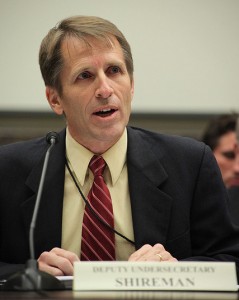The commission that accredits California’s community colleges, and has ordered City College of San Francisco to prepare for possible closure, has come under pressure from the federal government to make sure that the colleges under its jurisdiction comply in a timely way with the deficiencies it identifies.
If it does not, the commission risks losing its federal “recognition” as a legitimate accrediting agency – which it almost did five years ago when it reapplied for a renewal of its status from the U.S. Department of Education.
The pressures from Washington are being felt in local communities across California, where colleges are seeking renewal of their accreditation. They highlight an ongoing debate over whether the nation’s traditional self-policing system of accreditation – essentially by commissions established by colleges themselves – is the best way to ensure higher education quality and accountability.
Based in Novato, just north of San Francisco, the Accrediting Commission for Community and Junior Colleges – or the ACCJC as it is known by its unwieldy acronym – is responsible for accrediting California’s 112 community colleges. It currently has imposed a range of sanctions on 28 of them, the highest number in at least four years.
Assisted by a full-time staff, the commission consists of 19 members, most with close ties to the community colleges. Its current chair, Sherrill Amador, a former president of the Palomar Community College District near San Diego, has deep roots in the community college system. Barbara Beno, its longtime president, is a former president of Vista College in Berkeley (now called Berkeley City College). Several commission members are faculty members or administrators at colleges such as Sacramento City College, East Los Angeles City College and West Hills Community College District in the Central Valley.
For more details on the commission and the sanctions it imposes on colleges, go here.
The federal government’s increasing interest in the effectiveness of regional accrediting agencies like the ACCJC has been driven at least in part by concerns that students who receive federal financial aid receive a quality education – and don’t default on their loans. Colleges must be accredited in order to offer federal financial aid to their students.

Ocean Campus, one of a dozen locations of San Francisco City College, which is facing “show cause,” the highest level of sanctions that the Accrediting Commission for Community and Junior Colleges can impose.
Among the most severe sanctions the commission can impose is to order a college to “show cause” as to why it should not lose its accreditation, an action that would result in almost certain closure. That is a fate that the three California community colleges ordered to show cause – City College of San Francisco, the College of the Redwoods in Eureka and Cuesta College in San Luis Obispo – are now working hard to avoid.
But in 2007, the commission was itself found to be “non-compliant” by the U.S. Department of Education for failing to enforce the so-called “two year rule” enacted as a result of the reauthorization of the Higher Education Act in 1998. The rule requires colleges to come into compliance with concerns raised by their accrediting agencies within two years of being alerted to them, unless, as the commission has stated, “there are some rare and extenuating circumstances.”
As a condition of retaining its federal recognition, the ACCJC agreed to toughen the requirements it imposes on community colleges, as spelled out in a letter Beno sent to all colleges under its jurisdiction. These included setting “a specific date” within the two-year timeline by which deficiencies would have to be addressed. It also told the colleges it would “not extend beyond two years the accreditation of an institution that is deficient in accreditation standards that significantly affect educational quality or institutional integrity.”
“At risk is the commission’s recognition,” the ACCJC’s Barbara Beno told EdSource Today.
Arbiters of quality?

Robert Shireman
“This is a continuation of a 40- or 50-year effort to create a good balance between making sure taxpayer dollars are spent well and consumers are protected, and also providing higher education the space to be flexible and independent,” said Robert Shireman, director of California Competes, a nonprofit public policy organization in San Francisco. Shireman is the former deputy undersecretary of education in the Obama administration in charge of higher education.
The issue has come to a head in recent years as both Congress and the federal government have grappled with whether there is a better way to determine which colleges should be eligible to receive some of the $175 billion in federal student aid spent annually in the nation’s for-profit and nonprofit colleges and universities.
Other accrediting agencies across the United States are experiencing similar pressures. “We are very concerned about institutions not providing high-quality education,” said David Bergeron, the U.S. Department of Education’s acting assistant secretary for postsecondary education. “Since we rely on the accrediting agencies as the arbiter of quality, we pay attention to what they do.”
The review process when accrediting agencies apply for renewal for recognition by the federal government – which they must do every five years – has “gotten a lot more rigorous,” Bergeron said.
Federal regulators have been even tougher on the nearly 60 so-called “programmatic” accrediting agencies that accredit specific programs, such as those that offer degrees in subjects ranging from acupuncture to veterinary medicine.
In fact, over the past year alone, out of 34 programmatic accrediting agencies that applied for renewal of their recognition, one was denied recognition altogether, and an additional 30 were found to be “out of compliance” on one or more of the criteria set by the Department of Education. The accreditors were provisionally allowed to retain their recognition, but were given a year to submit a compliance report to show that they have corrected the issues raised by the Department.
Numerous California programs fall under the umbrella of these “programmatic” accreditors, which includes the American Bar Association, which accredits all law schools in California, and the American Psychological Association, which accredits Ph.D. programs at UC Berkeley and other California universities.
Bush era legacy
The pressures on accreditors escalated during the administration of President George W. Bush. The much-publicized Spellings Commission – named after Margaret Spellings, who became Bush’s Secretary of Education – excoriated the higher education community for, among many other alleged shortcomings, “a remarkable absence of accountability mechanisms to ensure that colleges succeed in educating students.”
One of its major conclusions was that
Accreditation, the nation’s large and complex public-private system of federal, state and private regulators, has significant shortcomings … The growing public demand for increased accountability, quality and transparency coupled with the changing structure and globalization of higher education requires a transformation of accreditation.
The Spellings Commission wanted to impose significant new requirements on both colleges and accrediting agencies. But, said Shireman, “the response from the higher education community was strong enough that they backed away. But in the process most associations and accrediting agencies promised to do a better job to ensure that colleges are paying attention to whether students are learning.”
The pressures on accrediting institutions have only increased under the Obama administration, which has also sought to crack down on for-profit colleges that rely on large amounts of federal financial aid, often with poor student outcomes and high student loan default rates.
A key part of the federal regulatory apparatus is the National Advisory Committee on Institutional Quality and Integrity, which is charged with recommending to the U.S. Secretary of Education whether an accrediting commission should receive or retain its federal recognition.
This spring, the committee – generally referred to by the acronym NACIQI, and pronounced “nasicky” – recommended effectively giving regional accrediting agencies a reprieve by recommending that the current system of accreditation be retained.
But it also stated that the accrediting commissions be more rigorous in their evaluations.

Jamienne Studley
“I think the accreditors are getting the message loud and clear,” said Jamienne Studley, the chair of the commission, who is also executive director of Public Advocates, a leading California public interest law firm based in San Francisco. “They are hearing the message collectively and are recognizing that they have to do better. I sense they are rising to the challenge.”
If accrediting commissions don’t hold colleges more accountable for student outcomes, the federal government may look for other ways to determine a college’s eligibility for student financial aid, Studley said.
Also on the table is the accreditation process itself. Rather than looking at what she called traditional “inputs” such as student-faculty ratios, college curricula and board of trustees issues during the accreditation process, she said, “we are increasingly looking at student outcomes.” By that she meant how successful students are in completing their education programs in a timely fashion, if at all – and how they do in the workplace once they graduate.
“I think we are in a transition period in accreditation,” she said.
Shireman said that a challenge facing accrediting agencies like the ACCJC is that the only real enforcement capability they have when they identify problems at a college is to threaten it with closure if it doesn’t respond adequately – what he called “the nuclear option.”
“The only way to have an impact is to do what you said you were going to do,” he said, referring to the accrediting agencies. “At some point you have to let the hatchet fall.”
To get more reports like this one, click here to sign up for EdSource’s no-cost daily email on latest developments in education.















Comments (2)
Comments Policy
We welcome your comments. All comments are moderated for civility, relevance and other considerations. Click here for EdSource's Comments Policy.
Joseph Georges 11 years ago11 years ago
Interesting. But I’m not aware of any evidence that other regional accrediting agencies have been as tough on community colleges as the ACCJC has been in its region. Louis Freedberg mentions no specifics despite his statement that “other accrediting agencies across the United States are experiencing similar pressures.” Looking at the record of the huge North Central Association, it seems that the issue of probation arose for just one CC in that region during 2011-12, and … Read More
Interesting. But I’m not aware of any evidence that other regional accrediting agencies have been as tough on community colleges as the ACCJC has been in its region. Louis Freedberg mentions no specifics despite his statement that “other accrediting agencies across the United States are experiencing similar pressures.”
Looking at the record of the huge North Central Association, it seems that the issue of probation arose for just one CC in that region during 2011-12, and that case involved lifting probation at Nebraska Indian Community College. No show-cause orders were issued for community colleges in the NCA region, though there was a private four-year institution in Ohio that received one. But during 2011-12 three of California’s community colleges were ordered to show cause as to why their respective accreditations should not be withdrawn.
Is it possible that California’s community colleges are worse than those in the 19 states of the North Central region?
Allan Fisher 11 years ago11 years ago
Freedberg leaves out the source of the Federal government’s pressure on the accreditation commissions’ to sanction more colleges, the very wealthy activists like Bill Gates who represent corporations and large foundations. The efforts to “improve accountability” through measured outcomes and the demand to push students through faster is likely to discourage students and limit educational opportunities.